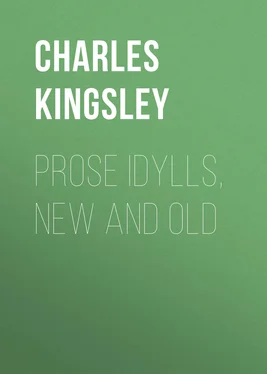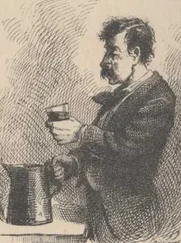Charles Kingsley - Prose Idylls, New and Old
Здесь есть возможность читать онлайн «Charles Kingsley - Prose Idylls, New and Old» — ознакомительный отрывок электронной книги совершенно бесплатно, а после прочтения отрывка купить полную версию. В некоторых случаях можно слушать аудио, скачать через торрент в формате fb2 и присутствует краткое содержание. Жанр: foreign_prose, foreign_antique, на английском языке. Описание произведения, (предисловие) а так же отзывы посетителей доступны на портале библиотеки ЛибКат.
- Название:Prose Idylls, New and Old
- Автор:
- Жанр:
- Год:неизвестен
- ISBN:нет данных
- Рейтинг книги:3 / 5. Голосов: 1
-
Избранное:Добавить в избранное
- Отзывы:
-
Ваша оценка:
- 60
- 1
- 2
- 3
- 4
- 5
Prose Idylls, New and Old: краткое содержание, описание и аннотация
Предлагаем к чтению аннотацию, описание, краткое содержание или предисловие (зависит от того, что написал сам автор книги «Prose Idylls, New and Old»). Если вы не нашли необходимую информацию о книге — напишите в комментариях, мы постараемся отыскать её.
Prose Idylls, New and Old — читать онлайн ознакомительный отрывок
Ниже представлен текст книги, разбитый по страницам. Система сохранения места последней прочитанной страницы, позволяет с удобством читать онлайн бесплатно книгу «Prose Idylls, New and Old», без необходимости каждый раз заново искать на чём Вы остановились. Поставьте закладку, и сможете в любой момент перейти на страницу, на которой закончили чтение.
Интервал:
Закладка:
And if it be not the quantity of feed, I know no clear reason why chalk and limestone trout should be so much larger and better flavoured than any others. The cause is not the greater swiftness of the streams; for (paradoxical as it may seem to many) a trout likes swift water no more than a pike does, except when spawning or cleaning afterwards. At those times his blood seems to require a very rapid oxygenation, and he goes to the ‘sharps’ to obtain it: but when he is feeding and fattening, the water cannot be too still for him. Streams which are rapid throughout never produce large fish; and a hand-long trout transferred from his native torrent to a still pond, will increase in size at a ten times faster rate. In chalk streams the largest fish are found oftener in the mill-heads than in the mill tails. It is a mistake, though a common one, to fancy that the giant trout of the Thames lashers lie in swift water. On the contrary, they lie in the very stillest spot of the whole pool, which is just under the hatches. There the rush of the water shoots over their heads, and they look up through it for every eatable which may be swept down. At night they run down to the fan of the pool, to hunt minnow round the shallows; but their home by day is the still deep; and their preference of the lasher pool to the quiet water above is due merely to the greater abundance of food. Chalk trout, then, are large not merely because the water is swift.
Whether trout have not a specific fondness for lime; whether water of some dozen degrees of hardness is not necessary for their development? are questions which may be fairly asked. Yet is not the true reason this; that the soil on the banks of a chalk or limestone stream is almost always rich—red loam, carrying an abundant vegetation, and therefore an abundant crop of animal life, both in and out of the water? The countless insects which haunt a rich hay meadow, all know who have eyes to see; and if they will look into the stream they will find that the water-world is even richer than the air-world.
Every still spot in a chalk stream becomes so choked with weed as to require moving at least thrice a year, to supply the mills with water. Grass, milfoil, water crowfoot, hornwort, starwort, horsetail, and a dozen other delicate plants, form one tangled forest, denser than those of the Amazon, and more densely peopled likewise.
To this list will soon be added our Transatlantic curse, Babingtonia diabolica , alias Anacharis alsin astrum . It has already ascended the Thames as high as Reading; and a few years more, owing to the present aqua-vivarium mania, will see it filling every mill-head in England, to the torment of all millers. Young ladies are assured that the only plant for their vivariums is a sprig of anacharis, for which they pay sixpence—the market value being that of a wasp, flea, or other scourge of the human race; and when the vivarium fails, its contents, Anacharis and all, are tost into the nearest ditch; for which the said young lady ought to be fined five pounds; and would be, if Governments governed. What an ‘if’.
But come; for the sun burns bright, and fishing is impossible: lie down upon the bank, above this stop. There is a campshutting (a boarding in English) on which you can put your elbows. Lie down on your face, and look down through two or three feet of water clear as air into the water forest where the great trout feed.
Here; look into this opening in the milfoil and crowfoot bed. Do you see a grey film around that sprig? Examine it through the pocket lens. It is a forest of glass bells, on branching stalks. They are Vorticellæ; and every one of those bells, by the ciliary current on its rim, is scavenging the water—till a tadpole comes by and scavenges it. How many millions of living creatures are there on that one sprig? Look here!—a brown polype, with long waving arms—a gigantic monster, actually a full half-inch long. He is Hydra fusca , most famous, and earliest described (I think by Trembley). Ere we go home I may show you perhaps Hydra viridis , with long pea-green arms; and rosea , most beautiful in form and colour of all the strange family. You see that lump, just where his stalk joins his bell-head? That is a budding baby. Ignorant of the joys and cares of wedlock, he increases by gemmation. See! here is another, with a full-sized young one growing on his back. You may tear it off if you will—he cares not. You may cut him into a dozen pieces, they say, and each one will grow, as a potato does. I suppose, however, that he also sends out of his mouth little free ova—medusoids—call them what you will, swimming by ciliæ, which afterwards, unless the water beetles stop them on the way, will settle down as stalked polypes, and in their turn practise some mystery of Owenian parthenogenesis, or Steenstruppian alternation of generations, in which all traditional distinctions of plant and animal, male and female, are laughed to scorn by the magnificent fecundity of the Divine imaginations.
That dusty cloud which shakes off in the water as you move the weed, under the microscope would be one mass of exquisite forms—Desmidiæ and Diatomaceæ, and what not? Instead of running over long names, take home a little in a bottle, put it under your microscope, and if you think good verify the species from Hassall, Ehrenberg, or other wise book; but without doing that, one glance through the lens will show you why the chalk trout grow fat.
Do they, then, eat these infusoria?
That is not clear. But minnows and small fry eat them by millions; and so do tadpoles, and perhaps caddis baits and water crickets.
What are they?
Look on the soft muddy bottom. You see numberless bits of stick. Watch awhile, and those sticks are alive, crawling and tumbling over each other. The weed, too, is full of smaller ones. Those live sticks are the larva-cases of the Caperers—Phryganeæ—of which one family nearly two hundred species have been already found in Great Britain. Fish up one, and you find, amid sticks and pebbles, a comfortable silk case, tenanted by a goodly grub. Six legs he has, like all insects, and tufts of white horns on each ring of his abdomen, which are his gills. A goodly pair of jaws he has too, and does good service with them: for he is the great water scavenger. Decaying vegetable matter is his food, and with those jaws he will bark a dead stick as neatly as you will with a penknife. But he does not refuse animal matter. A dead brother (his, not yours) makes a savoury meal for him; and a party of those Vorticellæ would stand a poor chance if he came across them. You may count these caddis baits by hundreds of thousands; whether the trout eat them case and all, is a question in these streams. In some rivers the trout do so; and what is curious, during the spring, have a regular gizzard, a temporary thickening of the coats of the stomach, to enable them to grind the pebbly cases of the caddises. See! here is one whose house is closed at both ends—‘grillé,’ as Pictet calls it, in his unrivalled monograph of the Genevese Phryganeæ, on which he spent four years of untiring labour. The grub has stopped the mouth of his case by an open network of silk, defended by small pebbles, through which the water may pass freely, while he changes into his nymph state. Open the case; you find within not a grub, but a strange bird-beaked creature, with long legs and horns laid flat by its sides, and miniature wings on its back. Observe that the sides of the tail, and one pair of legs, are fringed with dark hairs. After a fortnight’s rest in this prison this ‘nymph’ will gnaw her way out and swim through the water on her back, by means of that fringed tail and paddles, till she reaches the bank and the upper air. There, under the genial light of day, her skin will burst, and a four-winged fly emerge, to buzz over the water as a fawn-coloured Caperer—deadliest of trout flies; if she be not snapped up beforehand under water by some spotted monarch in search of supper.
Читать дальшеИнтервал:
Закладка:
Похожие книги на «Prose Idylls, New and Old»
Представляем Вашему вниманию похожие книги на «Prose Idylls, New and Old» списком для выбора. Мы отобрали схожую по названию и смыслу литературу в надежде предоставить читателям больше вариантов отыскать новые, интересные, ещё непрочитанные произведения.
Обсуждение, отзывы о книге «Prose Idylls, New and Old» и просто собственные мнения читателей. Оставьте ваши комментарии, напишите, что Вы думаете о произведении, его смысле или главных героях. Укажите что конкретно понравилось, а что нет, и почему Вы так считаете.












